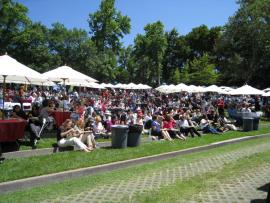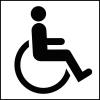
Stanford University ensures that its programs, services, goods and facilities are accessible to individuals with disabilities under requirements from the Americans with Disabilities Act (ADA) of 1990 and Section 504 of the Rehabilitation Act of 1973.
- Accommodations and Services
- Announcement Information
- Checklist for Planning an Accessible Event
- FAQs
Accommodations and Services
Under Title III of the ADA, a public accommodation must provide auxiliary aids and services to disabled people if necessary for the disabled person to use the entity's goods or services. However, the auxiliary aids and services would not be required if they would "fundamentally alter" the nature of the goods or services, or if they would result in an undue burden.
Examples of auxiliary aids and services which may be required include:
- Sign language interpreters
- Assistive listening devices
- Materials in enlarged print or braille
Examples of auxiliary aids and services which are personal in nature and may not be required include:
- Hearing aids
- Wheelchairs
- Personal assistants
Announcement Information
Q: How do I know what kinds of disability-related accommodations to provide at an event?
In order to inform guests/participants about how to request a disability-related accommodation, it is critical that information be included in flyers, advertisements or other materials that are distributed before an event. The announcement should include:
- Who the request should be made to (person or office)
- How a person can request an accommodation (phone, TTY or email)
- When the request should be made by (date usually at least one week in advance of the event)
Sample:
Disability-Related Accommodations and Services:
If you need a disability-related accommodation or wheelchair access information, please contact: ________(person/office), at phone: ________ or email: ________. Requests should be made by ________ (date usually at least one week in advance of the event).
If you have any questions about requests or resources for accommodations in response to your announcement, please contact the D&A Office.
Checklist for Planning an Accessible Event
___ Contact: Did you include an announcement about how to request a disability-related accommodation in printed/advertised materials?
___ Path of Travel: Is there a step-free route from the parking lot (disabled parking spaces) to the building entrance? Is this pathway clear of obstructions/barriers and suitable in all weather conditions (i.e. rainy/slippery)?
___ Entrances: Is the primary entrance wheelchair accessible? If not, see "Signage" below.
___ Signage: If the wheelchair accessible entrance is not the primary entrance, put a sign on the primary entrance saying where the accessible entrance is.
___ Restrooms: Be familiar with where the nearest wheelchair accessible restrooms are located.
___ Meeting Setup:
Rooms/Auditoriums: Are all meeting rooms wheelchair accessible (i.e. elevators available for upper levels)?
Chair Setup: When a room does not have fixed seats, keep in mind two principles for setting up wheelchair seating locations:
- The number of chairs to remove to create wheelchair seating locations depends on the total seating (see table below checklist); and
- Wheelchair locations should be integrated with other seating areas (chairs removed should be interspersed - front, middle, back, sides of room, etc.)
Tables/Information: Tables used for registration, interviewing, information display or other services/goods should be between 28-34" from the floor to the top of the table. If guests will be seated at the tables, knee space should be at least 27" from the floor to the bottom of the table.
Materials: If overhead projections, easels or dry erase boards will be used, it's helpful to provide everyone with the same information in hard copy format. In addition, some people with visual impairments require the type size to be enlarged; having a few copies on hand with 16 point type is helpful.
Food/Beverages/Info booths, etc.: Keep the following measurements in mind if you will be providing food or drinks, information, registration, use of machines/equipment, etc., at tables or booths:
- Table height: 28-34" from floor to top of table. If you must have some food placed higher than 34", be sure that at least a portion of such foods are available at the lower level.
- Aisles: At least 36" wide for maneuverability, and up to 44" wide if goods/services are available on both sides of an aisle.
- Knee space: 27" from floor to bottom of table if guests will be using tables for eating, writing, interviewing, receiving services, etc.
- Cables: Covers should be used over electrical cables or cords that must cross over aisles or pathways. Cable covers should be no more than 1/2" thick in order for wheelchairs to traverse across them.
___ Overnight Accommodations: If your event requires that participants find lodging overnight in the nearby vicinity, please review our list of wheelchair accessible hotels. You may want to use the International Symbol of Accessibility (see below) to identify wheelchair accessible hotels.

|
TOTAL SEATING CAPACITY |
REQUIRED NUMBER OF WHEELCHAIR LOCATIONS |
|---|---|
|
4-25 |
1 |
|
26-50 |
2 |
|
51-300 |
4 |
|
301-500 |
6 |
|
over 500 |
6 (plus 1 additional space for each total seating capacity increase of 100) |
FAQs
Prepare your event staff so that they will be able to answer the following frequently asked questions. If you do not know the answers to any of the following questions, or have other questions about disability-related accommodations at your event, please contact the D&A Office.
I have a state-issued disabled parking placard
Q: Where is the nearest parking area?
Know ahead of time where the nearest parking area is. Disabled parking placards can be used in ANY marked parking space on campus, including A, C and Z lots, metered spaces (no need to fill meter), service vehicle spaces and disabled parking spaces. Know the step-free path from the nearest lots to your event location.
I use a wheelchair
Q: How do I get from [point A] to [point B]?
Familiarize yourself with step-free pathways in the vicinity of the event (i.e. parking lot to main entrance) and to notable locations around campus, especially the Bookstore, Main Quad, Hoover Tower, etc.
Q: Where is the nearest wheelchair accessible restroom?
Know ahead of time where the accessible restroom is and how to get to it from your event location.
I need a device
Q: Do you have a teletypewriter (TTY) or Telecommunications Device for the Deaf (TDD) available?
Answer: Yes, there are several public TTYs on campus.
Q: How can I obtain an assistive listening device (ALD)?
Some campus auditoriums have permanent ALD equipment available (through the PA system), including Memorial Auditorium and Annenberg. ALDs can also be ordered through Event Services for other venues (please allow one week advance notice). It's helpful to have a designated event staff member in charge of disability-related accommodations and equipment (this person would be responsible for knowing where the ALDs are located and how to assist someone if such a request is made).


